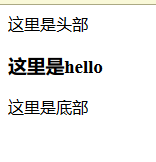组件通信
- 为什么要进行组件通信?
组件可以说是一个具有独立功能的整体,但是当我们要将这些组件拼接在一起时,这些组件相互之间要建立联系
,这个联系我们就称之为通信 - 组件通信的方式有以下几种( 王者级 )
- 父子组件通信
使用props来实现
- 父子组件通信
<div id="app">
<Father></Father>
</div>
<template id="father">
<div>
<h3> 这里是父组件 </h3>
<hr>
<Son :aa = "money" :mask-flag = "maskFlag" :maskFlag = "maskFlag"/>
</div>
</template>
<template id="son">
<div>
<h3> 这里是son组件 </h3>
<p> 父亲给了我 {{ aa }} 钱 </p>
<p> {{ maskFlag }} </p>
</div>
</template>
Vue.component('Father',{
template: '#father',
data () { // 为什么要将data定义为函数?
return {
money: 2000,
maskFlag: 10000000000
}
}
})
Vue.component('Son',{
template: '#son',
props: ['aa','maskFlag']
})
new Vue({
}).$mount('#app')
props
1. 在父组件的模板中将数据用单项数据绑定的形式,绑定在子组件身上
2. 在子组件的配置项中可以使用一个props配置项来接收这个数据,接收时,props的取值可以使一个数组
Vue.component('Son',{
template: '#son',
props: ['money']
})
-
在子组件模板中,接收到的属性可以像全局变量一样直接使用
父亲给了我 {{ money }} 钱
问题: 为什么data要定义为一个函数?
1. 组件是一个独立的个体,那么它应该拥有自己的数据,这个数据应该是一个独立的数据
2. 也就是说这个数据应该有独立作用域,也就是有一个独立的使用范围,这个范围就是这个组件内
3. js的最大特征是:函数式编程 , 而函数恰好提供了独立作用域
问题: 为什么data要有返回值?返回值还是一个对象?
1. 因为Vue是通过observer来观察data选项的,所有必须要有返回值
2. 因为Vue要通过es5的Object.defineProperty属性对对象进行getter和setter设置 -
子父组件通信
自定义事件
<div id="app">
<Father></Father>
</div>
<template id="father">
<div>
<h3> 这里father组件 </h3>
<p> 儿子给了我 {{ money }} </p>
<Son @give = "getHongbao"/>
</div>
</template>
<template id="son">
<div>
<button @click = "giveFather"> give </button>
<h3> 这里是son组件 </h3>
</div>
</template>
Vue.component('Father',{
template: '#father',
data () {
return {
money: 0
}
},
methods: {
getHongbao ( val ) {
console.log( 1 )
this.money = val
}
}
})
Vue.component('Son',{
template: '#son',
data () {
return {
hongbao: 500
}
},
methods: {
giveFather () {
//如何进行父组件给子组件的自定义事件触发
this.$emit('give',this.hongbao)
}
}
})
new Vue({
el: '#app'
})
注释
自定义事件
1. 自定义的 通过 $on 定义 $emit触发
2. 通过绑定在组件身上定义,通过 $emit触发
子父通信流程
1. 在父组件的模板中,通过事件绑定的形式,绑定一个自定义事件在子组件身上
<Son @aa = “fn”/> //这边要注意: fn是要在父组件配置项methods中定义
- 在子组件的配置项methods中写一个事件处理程序,在事件处理程序中触发父组件绑定的自定义事件
Vue.component('Son',{
template: '#son',
data () {
return {
hongbao: 500
}
},
methods: {
giveFather () {
//如何进行父组件给子组件的自定义事件触发
this.$emit('give',this.hongbao)
}
}
})
- 将子组件定义的事件处理程序 giveFather,绑定在子组件的按钮身上
<template id="son">
<div>
<button @click = "giveFather"> give </button>
<h3> 这里是son组件 </h3>
</div>
</template>
- 非父子组件通信
ref链: 可以实现非父子组件的通信,但是如果层级太多,就比较繁琐了 $attrs
<div id="app">
<Father></Father>
</div>
<template id="father">
<!-- 组件中根元素必须唯一 -->
<div>
<h3> 这里是father </h3>
<button @click = "look"> 点击查看father的this </button>
<p> father的 n: {{ n }} </p>
<hr>
<Son ref = "son"></Son>
<Girl ref = "girl" :n = "n"></Girl>
</div>
</template>
<template id="son">
<div>
<h3> 这里是 son 1 </h3>
</div>
</template>
<template id="girl">
<div>
<h3> 这里是girl </h3>
<button @click = "out"> 输出girl的this </button>
</div>
</template>
Vue.component('Father',{
template: '#father',
data () {
return {
n: 0
}
},
methods: {
look () {
this.n = this.$refs.son.money
}
}
})
Vue.component('Son',{
template: '#son',
data () {
return {
money: 1000
}
}
})
Vue.component('Girl',{
template: '#girl',
data () {
return {
num: 0
}
},
methods: {
out () {
console.log( this )
console.log( this.$attrs )
}
}
})
new Vue({
el: '#app'
})
bus事件总线
<div id="app">
<Bro></Bro>
<Sma></Sma>
</div>
<template id="big">
<div>
<h3> 这里是哥哥组件 </h3>
<button @click = "hick"> 揍 </button>
</div>
</template>
<template id="small">
<div>
<h3> 这里是弟弟组件 </h3>
<p v-show = "flag"> 呜呜呜呜呜呜呜呜呜uwuwuwuwu </p>
</div>
</template>
var bus = new Vue() // bus原型上是不是有 $on $emit
Vue.component('Bro',{
template: '#big',
methods: {
hick () {
bus.$emit('aa')
}
}
})
Vue.component('Sma',{
template: '#small',
data () {
return {
flag: false
}
},
mounted () { //当前组件挂载结束,也就是我们可以在页面当中看到真实dom
// mounted这个钩子函数的触发条件是组件创建时会自动触发
// 事件的声明
var _this = this
bus.$on( 'aa',function () {
_this.flag = true
console.log( this )//这里是this指的是bus, 但是我们需要的this应该是Sma这个组件
})
}
})
new Vue({
el: '#app'
})
注释
bus事件总线,我们是通过 $on来定义事件, 通过 $emit来触发事件
案例: 哥哥揍弟弟,弟弟哭
流程:
1. 在其中一个组件的 挂载钩子函数 上 做事件的声明
Vue.component('Sma',{
template: '#small',
data () {
return {
flag: false
}
},
mounted () { //当前组件挂载结束,也就是我们可以在页面当中看到真实dom
// mounted这个钩子函数的触发条件是组件创建时会自动触发
// 事件的声明
var _this = this
bus.$on( 'aa',function () {
_this.flag = true
console.log( this )//这里是this指的是bus, 但是我们需要的this应该是Sma这个组件
})
}
})
- 在另一个组件中 通过 bus.$emit(‘aa’)来触发这个自定义事件
app实例的手动挂载
new Vue({
}).$mount('#app')
自定义事件
-
自定义的 通过 $on 定义 $emit触发
var vm = new Vue({ el: '#app' }) // 自定义事件的定义( 发布 ) // vm.$on(自定义事件的名称,自定义事件的事件处理程序) vm.$on( 'aa', function () { console.log( 'aa' ) }) //自定义事件的触发 ( 订阅 ) // vm.$emit( 自定义事件的名称,自定义事件处理程序需要的参数1,参数2,参数3) vm.$emit( 'aa' ) -
通过绑定在组件身上定义,通过 $emit触发
<Son @aa = “fn”/>使用: 子父通信
组件的根元素必须有且仅有一个
动态组件
- 什么是动态组件?
可以改变的组件 - 使用
通过 Vue 提供了一个 component + is 属性 - 动态组件指的就是 component这个组件
- 案例
<div id="app"> <button @click = "change"> 切换 </button> <keep-alive include=""> <component :is = "type"></component> </keep-alive> </div>Vue.component('Aa',{ template: '<div> Aa </div>' }) Vue.component('Bb',{ template: '<div> Bb </div>' }) new Vue({ data: { type: 'Aa' }, methods: { change () { this.type = (this.type === 'Aa'?'Bb':'Aa') } } }).$mount('#app') - Vue提供了一个叫做 keep-alive 的组件可以将我们的组件进行浏览器缓存,这样当我们切换组件时,就可以大大提高使用效率
- keep-alive也可以以属性的形式呈现,但是我们如果搭配component的话,建议使用组件的形式
<div id="app">
<button @click = "change"> 切换 </button>
<!-- <keep-alive include="">
<component :is = "type"></component>
</keep-alive> -->
<component :is = "type"></component>
</div>
Vue.component('Aa',{
template: '<div> Aa </div>'
})
Vue.component('Bb',{
template: '<div> Bb </div>'
})
new Vue({
data: {
type: 'Aa'
},
methods: {
change () {
this.type = (this.type === 'Aa'?'Bb':'Aa')
}
}
}).$mount('#app')
slot 插槽
- 作用/概念: 预先将将来要使用的内容进行保留
<div id="app">
<Hello>
<div>
这里是地球
</div>
</Hello>
</div>
<template id="hello">
<div>
<slot></slot>
<h3>这里是hello</h3>
</div>
</template>
Vue.component('Hello',{
template: '#hello'
})
new Vue({
el: '#app'
})
运行结果:‘这里是地球’会插在这里是hello的前面
2. 具名插槽: 给slot起个名字
<div id="app">
<Hello>
<header slot = 'header'> 这里是头部 </header>
<footer slot = 'footer'> 这里是底部 </footer>
</Hello>
</div>
<template id="hello">
<div>
<slot name = "header"></slot>
<h3>这里是hello</h3>
<slot name = "footer"></slot>
</div>
</template>
Vue.component('Hello',{
template: '#hello'
})
new Vue({
el: '#app'
})
运行结果:

- 注意: 以上两种形式在 vue2.6以上被废弃























 1363
1363











 被折叠的 条评论
为什么被折叠?
被折叠的 条评论
为什么被折叠?








